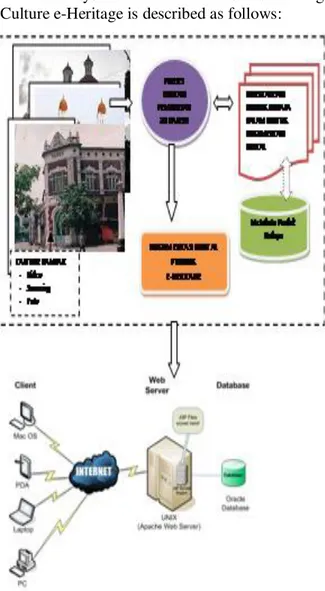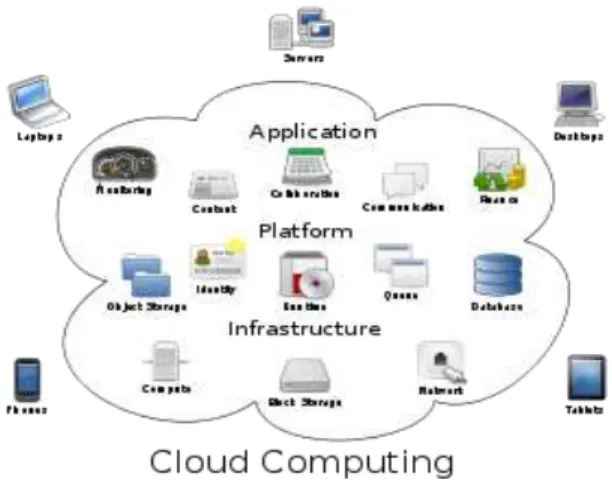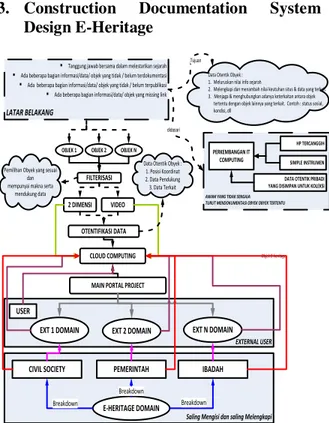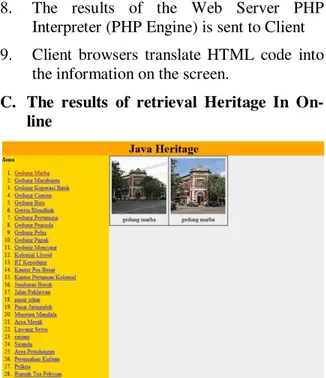Dokumentasi Dijital sebagai Metadata E-Heritage Warisan Budaya Semarang
dengan Teknologi Komputasi Awan
Digital Documentation as Metadata E-Heritage Semarang
with Cloud Computing Technology
Dewi Handayani Untari Ningsih, Dwi Budi Santoso danSaefurrohman
Informatic Engineering Department, Faculty Information Technology, Stikubank University email: dewindroider@gmail.com, nayantaka@gmail.com, saefurr@gmail.com
Abstract
Electronic Heritage (eHeritage) merupakan bentuk pendokumentasian produk warisan budaya (analog) ke dalam format digital. Perancangan electronic-Heritage (eHeritage) dalam bentuk dokumentasi dijital warisan budaya Semarang dilakukan untuk melestarikan salah satu kebudayaan yang ada di Jawa tengah melalui penerapan teknologi komputer bagi upaya pelestarian dan publikasi. Dokumentasikan secara dijital warisan budaya dengan menggunakan teknologi komputasi awan, yang dilakukan dengan merekam dan mengolah sejumlah besar data serta disimpan secara on-line, dengan memanfaatkan layanan komputasi awan sebagai tempat penyimpanan data e-heritage yang bisa diakses oleh semua orang, pengelolaan informasi dengan menggunakan API Flickr, visualisasi dan presentasi hasil pengolahan data bisa ditampilkan untuk berbagai aplikasi.
Electronic Heritage (eHeritage) is a form of cultural legacy product documentation (analog) into digital format. Designing electronic-Heritage (eHeritage) in the form of digital documentation of cultural heritage Semarang done to preserve one of the culture in central Java through the application of computer technology for the preservation and publication. Documented digital cultural heritage by using cloud computing technology, which is done by recording and processing large amounts of data and is stored in on-line, by utilizing cloud computing services as data storage e-heritage that can be accessed by everyone, management information by using the Flickr API, visualization and presentation of data processing can be
displayed for a variety of applications.
Kata kunci : e-heritage, teknologi komputasi awan, flickr
PREFACE
Cultural heritage is known as the cultural relics in ancient times, generally because the connotations have value that should be maintained or preserved its existence. While the `digital` itself is more than the basic of digital technology, the form of data that is processed in such a way that humans can apply it with a computer. Electronic Heritage (eHeritage) is a
form of cultural legacy product documentation (analog) into digital format.
Digital documentation of cultural heritage Semarang, designed in the form of electronic-Heritage (e-heritage) to preserve one of the culture in central Java through the application of computer technology in conservation efforts and publications.
Semarang cultural heritage in the form of digital documentation was made because it is
one unique town, there are 101 ancient buildings / historic sites in the city of Semarang are still to be protected, where many of the amount was being torn down by the owner, or damage, and subject to change functions. So it is necessary to store information about cultural heritage as one of the cultures in Central Java, as the nation's cultural heritage.
Documenting Cultural Heritage (Ikeuchi and Miyazaki, 2008), it is possible to generate 2-dimensional and 3-2-dimensional digital data. Permanently recording forms objects of cultural products in digital form using 2D and 3D visualization models (Levoy, et al, 2000; Beraldin et al, 2002; Stumfel et al, 2003; Guidi et al, 2004; Gruen et al, 2005; ment Guidi et al., 2006; Ikeuchi et al, 2007; El-Hakim et al, 2008; Remondino et al, 2009a).
With so many products available cultural heritage, digital documentation is performed in several stages, according to the characteristics of a region. And culture can be developed for other areas across the country.
Digital documentation of cultural heritage is done by:
a. Recording and processing large amounts of data are two (even three) multi-sorce dimensional, multi-resolution, multi-cultural information content about the products that you want to document.
b. Digitized inventory and sharing digital data for the purposes of education, research, conservation, entertainment, or travel destination.
c. Cultural heritage digitally documented using cloud computing technology.
d. Recording and processing as well as storing large amounts of data on-line.
e. Utilizing cloud computing services as data storage e-heritage that can be accessed by everyone
f. Managing information, using the Flickr API.
g. Visualization and presentation of data processing, can be displayed in a variety of
applications that allows to retrieve data via the Internet or online databases.
RESEARCH METHODES
A. Design System Construction
The system architecture of Semarang Culture e-Heritage is described as follows:
Figure 1. The system architecture of Semarang
Culture e-Heritage
B. Conceptual Design
EHeritage engineering software, intended for researchers, conservators, documentation specialists, museum curators, and the general public to access information about the cultural heritage of a region ("Anything, Anybody, Anytime, Anyhow, Anywhere") that can be accessed anywhere and working together in the
cultural heritage sector, who fought to preserve heritage together.
Standardization of digital design documentation eHeritage by PREMISE (May, 2005) in which a collection of metadata standards, information is managed from three viewpoints, namely administrative, technical and structures. Based on this structure any digital data that is marked as metadata under the main categories, namely: "object", "event", "agent" and "Right".
C. Design System and Action Plan
There are seven stages of the process to build the eHeritage documentation namely: 1. Content resource research
2. Digitization 3. Evaluation 4. Data management 5. Content and publishing 6. Metadata design and input.
Each phase, determine the relevant standard, the standard format, quality requirements and required information includes:
1. Resource Content Research
Cultural property tested and recorded in detail. This information is a source for digital data in the digital heritage. Some of the metadata standard used to record and describe the material culture and information given in the category of "electronic resource", "librararies", "archive", and "museum".
Based on these categories, can help identify the data based on the appropriate standard format. Types of cultural property to be considered by the media to record the object with the properties that do not materialize as sound or movement, form a fixed object such as maps or drawings, with a solid object like a sculpture and objects movies.
2. Digitization
Stages for making key data on digitization, first based on cultural property that is still original. Input devices can use digital
video cameras, scanners, digital cameras, 3-D scanners, digital audio recording, colimeter, colorimeter, etc.. Digital data created using the type of device to suit any physical object original source.
Documentation of data includes information not only from the public profile of data, but also the profile for each input device and the overall environment as well as color management profiles.
3. Evaluation
At this stage, the data have been made visually is evaluated.
4. Data Management
At this stage, the standard for managing primary and secondary digital data, is made from a digital master data. Five process performed for the data management are:
a. The selection of data format b. The selection of storage media c. Selection of the storage environment d. Documentation of data storage e. Data backup
5. Content and Publishing
Methods of publication, is determined by selecting one of the methods and formats to suit the purpose. Multiple types of content such as virtual reality theater format, edited and compiled as a package of digital data collection.
6. Metadata Design and Input
At this stage, in terms of standards for organizing and documenting all of the profile information as metadata, an alias, information on digital data. Profiles were collected at each phase of the above, information about each profile item, must be documented and stored in a single machine in a form that can be understood and displayed scheme for modeling RDF or XML.
Figure 2. Correlation metadata in every phase of Digital Documentation Process.
D. E-Heritage Data Processing With Cloud
Computing Technology
Figure 3. Cloud Computing Architecture
Cloud architecture consists of:
a. The server nodes who interconnected and communicate or exchange data through internet-based network protocol
b. Communication on cloud infrastructure, is communication between several components of the cloud (cloud controller, node controller) using the local network or a private network.
c. The role of TCP / IP is very important to support the exchange of data.
In the picture above, cloud position is in the middle of a website, which serves as a web interface. With cloud computing, the operating system along with its applications and storage, can be made directly via the Internet, thus saving a great physical computer procurement for corporate or personal needs.
E. Data Processing System E-Heritage
Architecture
1. Ancient Buildings / Historic Sites in the
city of Semarang Documentation
Historically, the city of Semarang has an area where the 18th century as a trade center. The area is now called the Old Town area.
Semarang Old City is a historic district, with many ancient buildings are considered to be very potential to be developed in the field of economic and cultural conservation areas
2. Digital Data Object
When the data obtained from the offices of Tourism, Regional Development Planning Board or less or none of the search results on-line and in the literature do not exist and if deemed needed detail objects, digital data is obtained by taking the picture.
Data retrieval shooting is done in two ways, namely data 2-dimensional photography and video. Then the data captured, categorized and classified according to the criteria in the department of tourism for sharing historic buildings in the city of Semarang.
Some photos document the building of the past, can be used as a comparison for the changes in the function of old and new buildings. Stasiun Tawang Susteran Ronggowarsio Tahun 2012 SMA 3 Tahun 1914 (source : http://www.semarang.go.id)
Figure 4. Example photos of Semarang
Ancient Buildings.
(source : Shooting author Mei 2012)
B
C
D
F
A
3. Construction Documentation System Design E-Heritage
Figure 5. E-Heritage Data Processing System
Architecture RESULT
The final result of this research is the digital documentation of historical objects obtained from field surveys, results of on-line digital objects existing which has been uploaded and then grouped together according to the theme of the history of each object.
Historical Buildings in the city of Semarang is classified by:
1) Old building 2) Historical Buildings
A. Directory Structure
All images in the form of documents either field surveys and videos are stored in a single directory and has managed in accordance with the name of the building or road to facilitate access. Management of files in a directory can be used to download the document to several on-line storage and are used for various applications. Virtual storage, performed with the concept of cloud computing, with regard to maintenance of documents that do not
depend on local storage. If the server is deemed inadequate due to the amount of data it is possible to further development with the use of server rental system.
B. Document Storage Services Cloud
Computing With Flickr
Figure 6. Document Storage Services Cloud
Computing with Flickr PHP Script Processing Mechanism
1. User typed address http://namadomain/ index.php
2. Http request is handled by the Web Server. 3. Web Server will fetch the file index.php,
and then given to the engine of PHP (PHP interpreter)
4. In the index.php file there is a flickr call function
5. Response from Flickr is a form of XML documents
6. The XML document contains information about the image url and description
7. PHP engine translates index.php file into HTML code
Saling Mengisi dan saling Melengkapi EXTERNAL USER FILTERISASI
OBJEK 1 OBJEK 2 OBJEK N
2 DIMENSI VIDEO
OTENTIFIKASI DATA CLOUD COMPUTING
MAIN PORTAL PROJECT
USER
Pemilihan Obyek yang sesuai dan mempunyai makna serta
mendukung data
EXT N DOMAIN EXT 2 DOMAIN
EXT 1 DOMAIN
Data Otentik Obyek : 1. Posisi Koordinat 2. Data Pendukung 3. Data Terkait IBADAH PEMERINTAH CIVIL SOCIETY E-HERITAGE DOMAIN Breakdown Breakdown Breakdown Objek E-heritage
§ Tanggung jawab bersama dalam melestarikan sejarah
§ Ada beberapa bagian informasi/data/ objek yang tidak / belum terdokumentasi
§ Ada beberapa bagian informasi/data/ objek yang tidak / belum terpublikasi
§ Ada beberapa bagian informasi/data/ objek yang missing link
LATAR BELAKANG
Data Otentik Obyek : 1. Meluruskan nilai info sejarah
2. Melengkapi dan menambah nilai keutuhan situs & data yang terkait. 3. Menjaga & menghubungkan adanya keterkaitan antara objek
tertentu dengan objek lainnya yang terkait. Contoh : status sosial, kondisi, dll
Tujuan
didasari
AWAM YANG TIDAK SENGAJA TURUT MENDOKUMENTASI OBYEK OBYEK TERTENTU
PERKEMBANGAN IT COMPUTING
HP TERCANGGIH
SIMPLE INSTRUMEN
DATA OTENTIK PRIBADI YANG DISIMPAN UNTUK KOLEKSI
8. The results of the Web Server PHP Interpreter (PHP Engine) is sent to Client 9. Client browsers translate HTML code into
the information on the screen.
C. The results of retrieval Heritage In
On-line
Figure 7. The Result of Retrieval Heritage In
On-line
Response XML file translated by index.php <photoset id="4" primary="2483" page="1" perpage="500" pages="1" total="2">
<photo id="2484" secret="123456" server="1" title="my photo" isprimary="0" />
<photo id="2483" secret="123456" server="1" title="flickr rocks" isprimary="1" />
</photoset>
D. Utilizing Web Document Storage
All documents are generated and stored using cloud computing services Flickr with consideration of the stored data is not private but the data can be shared by all those in need for the sake of cultural preservation. Flickr service selection with consideration of more structured, where the data is stored more easily classified.
CONCLUSION
1. The final result of this research is the digital documentation of historical objects obtained from field surveys, results of on-line digital objects existing which has been uploaded and then grouped together
according to the theme of the history of each object.
2. Digital documentation of cultural heritage Semarang, grouped in the form of ancient and historic buildings, using Flickr cloud computing services.
3. Utilization of Cloud Computing Technology as a place to store digital documents with storage considerations can be made directly via the Internet and accessible to all who need data about the cultural heritage of Semarang and procurement could save a great physical computer for storage and maintenance of documents that do not depend on local storage.
REFERENCES
Beraldin, J.-A., Picard, M., El-Hakim, S.F., Godin, G., Valzano, V., Bandiera, A. And Latouche, D., (2002). Virtualizing a Byzantine crypt by combining high resolution textures with laser scanner 3D data. Proc. Of VSMM 2002, pp. 3-14 El-Hakim, S.F., Beraldin, J.A., Picard, M.,
Godin, G., (2004). Detailed 3D reconstruction of large-scale heritage sites with integrated techniques. IEEE
Computer Graphics and Application,
24(3), 21-29
Fujimoto, CIPA (2009). Information Standard For Cultural Heritage With The ISO 191XX Series. CIPA Symposium, Kyoto Japan.
Gruen, A., Remondino, F., Zhang, L., (2005). The Bamiyan project:multi-resolution image-based modeling. In Recording,
Modeling and Visualization of Cultural
Heritage, E.Baltsavias, A.Gruen, L.Van
Gool,
Guidi, G., Beraldin, J-A., Atzeni, C., (2004). High accuracy 3D modeling of Cultural
Heritage: the digitizing of Donatello’s
Maddalena, IEEE Transactions on Image
Processing, 13(3), 370-380
Guidi, G., Frischer, B., Russo, M.,Spinetti, A., Carosso, L., Micoli, L.L., (2006).
Three-dimensional acquisition of large and detailed cultural heritage objects. Machine
Vision Applications, 17, 349-360
Guidi, G., Remondino, F., Russo, M., Menna, F., Rizzi, A., Ercoli, S., (2009). A multi-resolution methodology for the 3D modeling of large and complex archaeological areas. International
Journal of Architectural Computing, 7(1),
40-55
Ikeuchi, K., Miyazaki, D., (2008). Digitally Archiving Cultural Objects. Springer, 503 p., ISBN: 978-0-387-75806-0
Lensch, H. P. A., Kautz, J., Goesele, M., Heidrich, W., Seidel, H.-P., (2003). Image-based reconstruction of spatial appearance and geometric detail. ACM
Transaction on Graphics, 22(2), 234–257
Levoy, M., Pulli, K., Curless, B., Rusinkiewicz, S., Koller, D., Pereira, L., Ginzton, M., Anderson, S., Davis, J., Ginsberg, J., Shade, J., Fulk, D. (2000). The Digital Michelangelo Project: 3D scanning of large statues. SIGGRAPH Computer
Graphics Proceedings, 131-144
PREMIS, (2005). Data Dictionary for
Preservation Metadata,
http://www.loc.gov/standards/premis/v2/ premis-2-0.pdf (achcessed 23 July 2009). Remondino, F., El-Hakim, S., (2006).
Image-based 3D modelling: a review. The
Photogrammetric Record, 21(115),
269-291
Remondino, F., El-Hakim, S., Gruen, A., Zhang, L., (2008). Development and performance analysis of image matching for detailed surface reconstruction of heritage objects.
IEEE Signal Processing Magazine, 25(4),
55-65
Stumpfel. J., Tchou, C., Yun, N., Martinez, P., Hawkins, T., Jones, A., Emerson B, Debevec, P., (2003). Digital reunification of the Parthenon and its sculptures. Proc.
of Virtual Reality, Archaeology and
Cultural Heritage (VAST 2003), pp.



